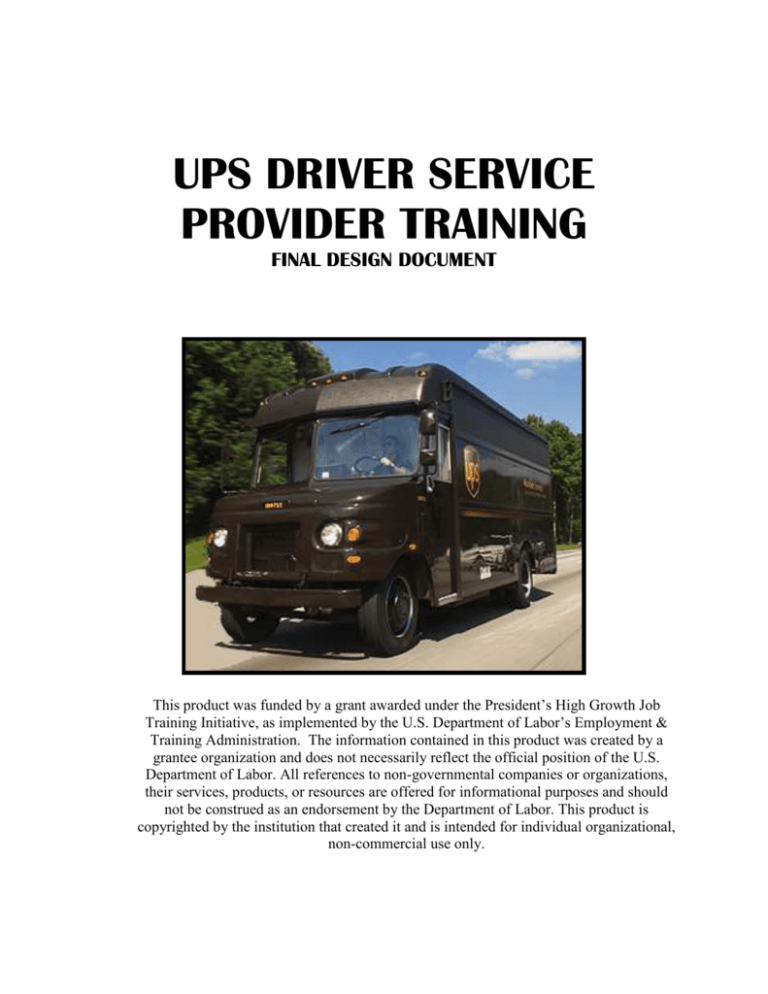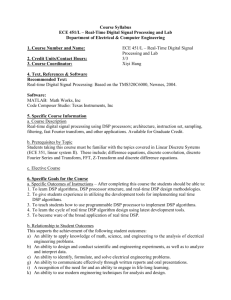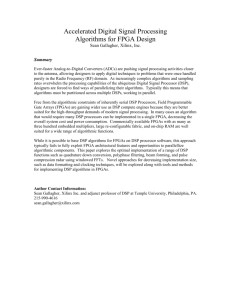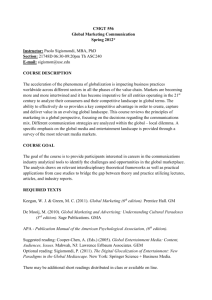Service Provider Research Design Document
advertisement

UPS DRIVER SERVICE PROVIDER TRAINING FINAL DESIGN DOCUMENT This product was funded by a grant awarded under the President’s High Growth Job Training Initiative, as implemented by the U.S. Department of Labor’s Employment & Training Administration. The information contained in this product was created by a grantee organization and does not necessarily reflect the official position of the U.S. Department of Labor. All references to non-governmental companies or organizations, their services, products, or resources are offered for informational purposes and should not be construed as an endorsement by the Department of Labor. This product is copyrighted by the institution that created it and is intended for individual organizational, non-commercial use only. INTRODUCTION OVERVIEW Introduction The design for the new Driver Service Provider (DSP) Training curriculum takes a dynamic, interactive approach to developing those who aspire to what is arguably the most important position at UPS – the Driver Service Provider. Integrating work from four cutting-edge organizations: RDEA, Virginia Tech, MIT and Brainvisa, Inc., the resulting learning experiences will appear seamless to the candidate while offering state-of-theart, blended learning solutions for optimal learning. Design Concepts The design concepts presented in this design document use a blended learning approach to design by integrating a variety of training methodologies, learning strategies and facilitation methods. This design also takes full advantage of the synergy created by multiple trainers in a centralized (regional) training location. Three distinct phases are described in the high-level design: Prequalification, Workshop, and Post-Workshop. To achieve the most successful learning experience calls for cooperation from each Center and Hub where Prequalification and PostWorkshop experiences take place. Ongoing Driver Development While ongoing driver development after seniority is not included in the scope of this project, it is mentioned here to emphasize the importance of continuous reinforcement of safety habits and customer care as well as updates to UPS DSP methods and procedures. REGIONAL TRAINING CENTER Overview One of the primary changes from the current New Service Provider Training (NSPT) to the proposed Driver Service Provider (DSP) Training is a change in the training venue from district-based training to a regional training concept. Transitioning to a Regional Training Center (RTC) model has been recommended to alleviate these real-world implementation issues. A regionally based training center will build in greater accountability for properly training DSPs and reduced failure rates through the use of training codes associated with the training pool rather than compiled with overall production statistics.. Furthermore, there will be additional economies of scale for UPS. While travel costs (suitcased trainees) would be greater for an RTC, this increased cost would be more than offset by decreased costs indicated in the table below. Economy Facility Trainees Facilitation Economies of Scale RTC Equipping, upgrading, maintaining, and supporting 12 RTCs Space and facilitator ratio allows greater flexibility for expansion to prepare for peak Fewer total facilitators are needed; yet there will be more facilitators available per training session. For instance, 12 RTCs with 4 facilitators (48) is still less than providing one facilitator per DTC (55). DTC Equipping, upgrading, maintaining and supporting 55 DTCs Space and facilitator ratio limits flexibility for expansion to prepare for peak Many DTCs are operating with only one facilitator (55 x 1 = 55); There is no qualified backup when the trainer is sick, on vacation, or otherwise unavailable. Improved outcomes (reduced failure rate, improved productivity and customer service, etc.) would translate into substantially greater return on investment than attempting to continue with the DTC model. It is important during this project to collect baseline data that can be used to determine the success of the Regional Training Center pilot. In addition to increased class capacity and improved efficiency and synergy for facilitators and participants, there are several other indirect benefits to UPS in moving to an RTC model. 7/21/2006 High-Level Design - UPS/DOL Driver Service Provider Curriculum Page 3 Other Indirect Benefits Curriculum DSP Upgrade Curriculum Quality Improved Consistency and Maintenance of Training Increased Accountability for DSP Training Workforce Less bench time between training and DSP experience DSP Job Satisfaction/ Quality Improved Workforce flexibility DSP Job Attraction Improves Recruitment DSP Trainer Job Satisfaction /Quality Long-term increase in retention of drivers DSP Trainers assist with road tests and monitoring (frees up ORS) ORS Job Satisfaction / Quality UPS-Wide Enhanced UPS image for all careers Leverage Training Facility for other purposes Improved Customer Service Satisfaction Logistics It is anticipated that the RTCs will be needed for DSP workshops and prequalification about 40 weeks per year. It is likely, and recommended, that UPS use the RTCs for other workshops and events. The Regional Training Center concept presents an excellent opportunity for building UPS bench strength through development opportunities that will provide additional support at the Regional Training Centers. UPSers at all levels of the organization will benefit from spending time in learning environments where UPS safety, services, methods, roles and responsibilities, training, and facilitation are being practiced through applied hands-on activities. UPS has identified Landover, Maryland as the pilot site location. Prequalification for DSP New Hires Approximately 1 in 6 DSP Candidates will be a new hire. Presently, new hires often attend the workshop without any preparation. In the future, new hires will be able to complete Prequalification requirements at the RTC prior to the workshop. By preparing UPS new hires for the role of DSP at the RTC, there is a direct benefit that should also contribute to lowering the failure rate. The accessibility of RTC and DSP Workshop resources will allow UPS to leverage facilitators, equipment, and a learning environment conducive for new hires to complete prequalification requirements as successfully as candidates who are presently employed by UPS (such as preloaders and air drivers). In the morning and afternoon, when whole class activities are taking place in the DSP Workshop, at least one facilitator will be available to train and support new hires. DSP Workshop Facilitation The DSP workshop has been designed to share UPS culture, job knowledge, skills, and attitudes each day in an engaging hands-on, interactive, blended learning environment. DSP Candidates will become accustomed to having a set routine as each day has been APPENDIX High-Level Design - UPS/DOL Driver Service Provider Curriculum 7/21/2006 structured to follow a similar format, building in complexity and raising performance standards as the week progresses. Each session requires a minimum of three (3) facilitators to accommodate a maximum of 24 DSP Candidates. The number of learning stations and time at each station has also been optimized for no fewer than three facilitators and no more than 24 DSP Candidates. Logistics for this configuration are detailed in the Appendix. While a minimum of three facilitators are needed for 24 participants, it is recommended that additional training resources be used to allow for greater flexibility. For example, additional support such as Certified Driver Trainers might be able to handle the driving experiences of DSP candidates; or co-facilitators might assist and support candidates at learning stations. If one of the primary facilitators is absent/unavailable, the class will be able to continue using the two remaining facilitators and supplementary resource(s). Additional training support will also be needed in preparation for peak or for other situations when trainee headcount is higher than 24 per session. As additional candidates are added, it will also be necessary to plan accordingly to provide for additional facilitators, drivers, workstations, learning stations, equipment, space, or a staggered schedule. In order to make this work efficiently, most of the topics in the DSP workshop have been modularized. Learning stations focus on different job competencies with learning objectives becoming progressively more complex each day. Participants will be grouped so that each team rotates through every learning station during the day. Participants will be assessed on a regular basis, based on learning objectives. Facilitators will be able to monitor individual DSP Candidate’s progress throughout the workshop and provide feedback and guidance. Under this new configuration, facilitators will be available to manage classroom activities while additional facilitators are free to conduct driving instruction and other hands-on activities to be completed outside the classroom. At any point, facilitators may rotate duties; or if one of the hands-on facilitators is free, he or she may come in to provide additional support in the classroom. The modular approach extends to driving experiences and any other hands-on activities outside the classroom. Groups will rotate through these experiences, which will be led by facilitators and/or Certified Driver Trainers. 7/21/2006 High-Level Design - UPS/DOL Driver Service Provider Curriculum Page 5 AUDIENCE A potential UPS Driver Service Provider candidate may come from one of four pools: Pre-Loaders Loaders Air Drivers External Hires The National Master United Parcel Service Agreement with the International Brotherhood of Teamsters prescribes a hiring pool ratio of 6:1, favoring experienced UPS employees (pools 1, 2, and 3) to external candidates (pool 4). Following are examples of how a potential candidate from each job pool might experience the new DSP training. APPENDIX High-Level Design - UPS/DOL Driver Service Provider Curriculum 7/21/2006 7/21/2006 High-Level Design - UPS/DOL Driver Service Provider Curriculum Page 7 APPENDIX High-Level Design - UPS/DOL Driver Service Provider Curriculum 7/21/2006 INTEGRATION OF ANALYSIS FINDINGS Design of the curriculum was based on a careful review of key findings from the UPS Analysis Report and Literature Review. Listed below are the design solutions used to address each UPS based its curriculum design on. Design Solution An introduction to the DIAD will be included in the Prequalification phase. Only candidates who have passed prequalification criteria will be allowed to move on to the workshop. The background on driving history will be more stringent regarding accidents and traffic violations. The background check will include a work ethics component (absenteeism/lateness for work). Assessment of driving skills will be conducted by a Certified DSP Trainer in each center. Consistent qualifications for this role will be developed during the design process. An Information Session and “So You Want to Be a UPS Driver Service Provider” will be designed to present an overview of the job and emphasize the importance of the skills presented during training. Candidates will be required to demonstrate their understanding and memorization of the Five Seeing Habits and 10-pt. Commentary in order to qualify to attend the Workshop portion of the training. In the Prequalification phase, topics like S&V and the 10-pt. Commentary will use an interactive learning approach to help with memorization and practice. CBT modules (e.g. DIAD) will be designed to be highly interactive. Prequalification experiences will focus on need-to-know preparation for the Workshop. Design focuses on hands-on, experiential learning. Facilitators will be able to focus on trainees as they observe, demonstrate, respond to questions, provide feedback, and evaluate DSP Candidates. Prequalification will: include driving experience opportunities for candidates who are unfamiliar with standard shift require candidates to demonstrate specific driving skills prior to attending the workshop Workshop includes daily, progressive driving experiences for candidates. This includes instruction on preparing for and driving training routes. Time study and work measurement components will be built into training. These components will use a graduated progression of complexity, which will provide candidates with a realistic feel for the time constraints they will experience on the job. 7/21/2006 High-Level Design - UPS/DOL Driver Service Provider Curriculum Page 9 Design Solution In the Workshop, the number of CBT modules will be reduced. Remaining CBTs will be redesigned (e.g. DIAD) to be highly interactive. A variety of self-directed learning stations will use a blended learning approach to achieve handson experiential learning for several topics, including methods, safety, body mechanics, customer focus and driving. Training content will be updated, beginning in the Detailed Design phase of this project. An ongoing schedule for maintenance of completed training materials will be developed by UPS. Implementation of a Regional Training Center concept will: Promote improvement of facilities and equipment while making the most efficient use of all training resources. Provide more facilitators during the workshops who can facilitate different activities simultaneously. Evaluation will be an ongoing element throughout all phases of the training. Progress of a candidate can be reviewed by facilitators or managers at any point in training Data about DSP candidates will carry over to the Center and continued progress reported during the Post-workshop phase Structured approach with training routes and graduated loads will be developed for the Postworkshop phase. Successful implementation of the new training program will require a firm commitment by UPS management and center personnel to the Post-workshop activities. A formal evaluation process will be developed for the Post-workshop phase. The Post-Workshop phase does not require the ORS to act as the Certified Driver Trainer . However, each center will need to identify at least one person who can perform in this role. The ORS will, however, be heavily involved in the last two weeks of Post-Workshop training. The workshop will include scenarios for different types of routes that increase in complexity. The Post-workshop phase uses graduated routes as an integral part of the learning experience. Create a separate training code that accounts for DSP candidate production (by region) to build in training accountability without adversely impacting production data. APPENDIX High-Level Design - UPS/DOL Driver Service Provider Curriculum 7/21/2006 Design Solution Recommend extending the post-training period from 30 days to 60 days – a change that would need to be endorsed by the National Master United Parcel Service Agreement and local agreements. Recommend increasing the flow of DSP candidates to reduce or eliminate time gap between successfully completing the DSP Workshop and acquiring 30 days of route and production driving experience. 7/21/2006 High-Level Design - UPS/DOL Driver Service Provider Curriculum Page 11 INTEGRATION OF LITERATURE REVIEW RECOMMENDATIONS The focus of the Literature Review was on generational differences. Similar to the Analysis findings, recommendations made in the Literature Review have been considered in the High Level Design. Listed below are recommendations from the Literature Review that potentially impact the design of the DSP training, along with design solutions appropriate to each recommendation. Literature Review Recommendation Design Solution General Recommendations Modify recruitment, retention, working conditions, and learning environments as needed to better meet employee and organizational needs. One avenue to increase this pool will be to add potential DSP Candidates without prior experience driving standard shift vehicles. This can be accomplished by offering optional driving instruction and practice at the beginning of the prequalification phase, or by recommending outside sources for training on a manual transmission. The Prequalification phase will provide potential candidates with a realistic overview of the position before they commit to pursuing training. This will lower the attrition rate (and training costs) for candidates who are not a good fit for the position. Improved prequalification requirements and evaluation prior to the Workshop phase of training will reduce likelihood of failure and should substantially reduce drop-out rates of DSP candidates. By conducting training at a regional level, UPS will be able to take advantage of economies of scale to provide a faster ROI on improved facilities, equipment, and personnel. Regional Training Centers will accommodate larger class sizes to meet the need to train more drivers – particularly during peak times. Appeal to generational values for work to have deeper personal meaning by communicating positive aspects about organizational culture. The introductory message presented during Prequalification will be designed to appeal to the personal work ethics and values of all workers to be committed to excellence. The final topic in the Prequalification phase (UPS Expectations) emphasizes ethics and commitment. Improve learning by using real-world problems and in-context learning that can be practiced in a safer environment. The new training design integrates practical, hands-on experiences related to all aspects of the job. Daily learning stations, driving experiences, and postworkshop OJT sessions will introduce real-world problems that grow in complexity with each iteration. Global Impact APPENDIX High-Level Design - UPS/DOL Driver Service Provider Curriculum 7/21/2006 Literature Review Recommendation Respond to ongoing changes in technology, global competition, and workforce demographics by uniting a diverse workforce with new learning and mutual respect. Design Solution Teamwork will be a central theme of training. The Prequalification and Post-Workshop phases will make use of the expertise of experienced Certified Driver Trainers, thereby furthering the value and importance of working together toward common goals. The Workshop phase will place Candidates on learning teams who will be charged with helping each other stay on task and complete assignments on time. Learning Technologies / Delivery Methods Recognize differences in how generations prefer to communicate; communication style and format can save a lot on productivity and efficiency. Deliver it (training) their way or in multiple formats. The difference between and among generations makes it a greater challenge to deliver learning in a one-size fits all approach. Add fun and interest to the workplace; try new learning strategies. Investigate the appropriateness of computer games and simulations for training. Collaborate with universities and other entities to research the potential learning and productivity gains that may be achieved through gaming strategies and training simulations. Identify appropriate media and technologies for instruction based on accessibility, cost effectiveness, and appropriateness for the situation. Training will be developed using multiple platforms that will appeal to communication styles across all generations. Text, audio, video, CBT, simulations, and hands-on learning will all be combined to provide an optimal blended learning experience during training. The DIAD training under development by Brainvisa, Inc. will offer an innovative approach that combines CBT with the actual DIAD (Workshop phase) and integrates a self-paced workbook with DIAD practice (Prequalification phase). The Body Mechanics learning stations under development by Virginia Tech will create new interactive approaches to deliver training on topics such as safety, ergonomics, etc. Defensive driving simulation will present realistic, progressive defensive driving scenarios. Hands-on learning stations for topics like Body Mechanics and Pretrip inspection will be more engaging and efficient yet cost effective when implemented at the regional level. The delivery method employed for every module has been carefully thought out based on when and how it must be delivered – as well as what is most effective for that particular topic. For example, the DIAD introductory training in the Prequalification phase will be delivered using a workbook and DIAD, so that participants can practice at the Center or possibly away from the job. In the Workshop, the DIAD training will take advantage of the power of CBT combined with a DIAD interface to the computer. Integrate learning and support into online enterprise resources. The use of a company-wide LMS tracking system will give facilitators and management a way to track individual training performance and to roll information up to the Center, District, Regional, or National levels. An LMS will also enable linkage to performance and cost data. 7/21/2006 High-Level Design - UPS/DOL Driver Service Provider Curriculum Page 13 Literature Review Recommendation Design Solution Intergenerational Synergy Connect knowledgeable experienced employees (Silent Generation and Baby Boomers) to support new employees (Gen X, Net Gen, and Retirees) APPENDIX Highly skilled drivers will become Certified Driver Trainers and will assist in the Prequalification and Post-Workshop phases to bring their prior knowledge and experience to new DSP Candidates. In many cases, these Certified Driver Trainers may be from the Silent Generation and Baby Boomer generation, while Candidates will come increasingly from Gen X and Net Gen. High-Level Design - UPS/DOL Driver Service Provider Curriculum 7/21/2006 INTEGRATION OF LEARNING THEORY The new DSP training design incorporates a variety of effective learning theories. However, the following learning concepts are central to the design. Primary Learning Theories Employed Behavioral learning theory Def.: Behavior is observed both before and after training has been implemented, and the observed changes in performance are related to what occurred during the intervention. The design of DSP training includes the following behavioral learning concepts. Learning objectives will be written for each learning activity. An evaluation strategy will be developed to measure change in behavior connected to the objectives outlined. Results of the evaluation will be tracked by the Learning Management System and Dashboard as determined by UPS. Constructivist learning theory Def.: Constructivism says that one’s knowledge, and the learning process itself, are rooted in a person’s unique interpretation of the world. Constructivism speaks to the design of learning environments rather than didactic instructional sequences. The new DSP training incorporates constructivism in the following ways: Candidates will experience learning stations where they can explore each skill and topic. Candidates will be presented with both well-structured problems (where the beginning and expected solutions are structured) and ill-structured problems (where the parameters are more vague, and the outcome may have more than one solution – just like problems typically encountered in everyday life.) Situated learning theory Def.: Situated learning occurs when students work on authentic tasks that take place in a ‘real-world’ setting. The new DSP training will take advantage of situated learning through: Learning strategies aligned with the goals of instruction. The skills to be learned will be taught in a context that mirrors the application of those skills on the job. Hands-on learning sessions will allow the learner to experience real-life situations (e.g. driving sessions, use of DIAD, package handling, etc.). Learning occurs through these experiences, and is immediately applicable to the job. Prequalification, Workshop, and Post-Workshop phases will all involve realworld experiences. At each step in the learning process, those experiences will be orchestrated to be progressively more complex. 7/21/2006 High-Level Design - UPS/DOL Driver Service Provider Curriculum Page 15 Gagne’s Nine Events of Instruction Def.: Conditions to help facilitate the process of learning. These nine conditions are: 1. Gain attention 2. Inform learner of objectives 3. Stimulate recall of prior learning 4. Present stimulus material 5. Provide learner guidance 6. Elicit performance 7. Provide feedback 8. Assess performance 9. Enhance retention and transfer Following are examples of the integration of Gagne’s Nine Events of Instruction in the design of DSP training. The Prequalification phase of the learning is designed in part to address #s 1, 2, and 3. The candidate is presented with an overview of the position as well as objectives for the training. They are encouraged to make use of skills they have learned on the job (e.g. candidates who have prior experience as a Loader or Air Driver) to create a bridge to the new skills to be learned. Throughout all phases of the training, these three steps are engaged - at the beginning of each day and at the beginning of each learning experience. Every learning experience is considered stimulus material (#4). This may also be thought of as the training content. The new DSP training design focuses more on facilitation (i.e. #5 – “provide learner guidance”) rather than on the presentation of information. Condition 6 calls for the candidate to perform the new skill. Concepts and skills included in the DSP training are reinforced through practice and performance, during which candidates will receive coaching and feedback. The source of the coaching and feedback (#7) will vary (e.g. Facilitator, CBT, Expert Driver, self-assessments), depending on the delivery method. At the end of each learning module, performance will be assessed (#8). Again the methodology for this assessment will vary, depending on the delivery method for the skills taught. Online modules will use Technology Based Learning Assessments, while hands-on modules will most often require observation and feedback. Finally candidates are encouraged to continue to grow – through the PostWorkshop phase and beyond. Implementation of ongoing driver development by UPS will reinforce critical values and skills for all Driver Service Providers. (Note that ongoing development beyond the Post-Workshop phase is not within the scope of this project.) APPENDIX High-Level Design - UPS/DOL Driver Service Provider Curriculum 7/21/2006 UPS Instructional Philosophies Aside from the learning theories reviewed above, UPS subscribes to several key philosophies we have found to be effective when working with adults. Developing clear instructional objectives to drive design, development and evaluation Creating blended learning solutions as appropriate to the training content Offering self-directed learning whenever possible Making clear connections between content and practice Encouraging regular self assessment and reflection Allowing participants to make choices concerning when and how they learn Providing regular feedback to participants on their performance and progress Soliciting continuous feedback from participants on the effectiveness of learning activities Presenting interactive, hands-on learning in the context of the job as much as possible Providing timely data on the progress of participants and on the effectiveness of instruction to Instructors, Managers, and other important decision-makers. 7/21/2006 High-Level Design - UPS/DOL Driver Service Provider Curriculum Page 17 Recommended Facilities – Minimum Configurations UPS Driver Service Provider Regional Training Center Layout Restrooms/Breakroom, etc. Doo r Door Doo r Main Classroom Doo r Door Breakout Room 1 Breakout Room 2 Breakout Room 3 Doo r Door Learning Stations Trainer Offices Door or Do Prequalification Training Area Example of Regional Training Center layout overall. APPENDIX High-Level Design - UPS/DOL Driver Service Provider Curriculum 7/21/2006 Example of Main Classroom, breakout rooms, and outside DSP training areas. 7/21/2006 High-Level Design - UPS/DOL Driver Service Provider Curriculum Page 19 CURRICULUM PLAN AND DESIGN The Curriculum Plan for the DSP training encompasses training preparation and activities through Prequalification, Workshop, and Post-Workshop. Goals for the design of the DSP curriculum have been outlined based on the findings from the Analysis Report, the Literature Review, and on key learning theories. In addition, UPS desires a competency-based model based on the role and responsibilities for the DSP position. DSP Training Curriculum Prequalification: Daily Topics Information Session So You Want to be a UPS Driver Service Provider? Driving Instruction and Practice Practical Driving Test Background Check DSP Preparation Kit Integrated DIAD (Intro) Safety S&V & 10-pt. Commentary & HABITS Services & Methods Ride-Along Qualification Exam UPS Expectations Monday Tuesday Wednesday Thursday Friday HAVE A SET ROUTINE “Aim High in Steering” WORKING TOGETHER “Get the Big Picture” PLANNING AHEAD “Keep Eyes Moving” SMOOTH OPERATOR “Leave Yourself an Out” EFFICIENCY & EFFECTIVENESS “Make Sure Others See You” Introduction Workshop Intro/DSP Role Review Preview /Policy#1 Review/Preview/ Policy#2 Review/Preview/ Policy#3 Review/Preview /Policy#4 UPS History/Culture UPS History – Video Organization & Support Dispatch/Routes Factoring in Time Future Have a Set Routine Components of DSP day Uniform, stretching, PCM Uniform, stretching, PCM Uniform, stretching, PCM Uniform awards, PCM Inside AM DIAD, pretrip, DVIR Inside AM /route Inside AM / route Inside AM / route Inside AM /Pretrip awards Learning Stations: Become progressively more complex as the week goes on. Candidates may repeat stations as needed to successfully complete assessments. A. B. C. D. E. Integrated DIAD S&V 5 Seeing Habits 10 pt. Commentary Package Handling Customer Focus Driving Experience F. G. H. I. J. Body Mechanics – Personal Body Mechanics – Package Car Defensive Driving Selection Methods Integration Station Pickup/Del. Competition Pickup/Del. Competition Route Competition Time Study Competition Review / skill assessment Inside PM / Daily Debrief / Recap Intro to PM; daily Q&A Competition Complete PM; daily Q&A Competition Complete PM; daily Q&A Competition Complete PM; daily Q&A Competition Post-Workshop expectations; evaluations Post-workshop: APPENDIX Hands-on graduated routes. Final examination after completion of all post-workshop activities. High-Level Design - UPS/DOL Driver Service Provider Curriculum 7/21/2006 EVALUATION EVALUATION CONCEPTS Introduction The re-designed curriculum for new DSPs addresses organizational needs and identified gaps. While it is anticipated that outcomes and ROI will improve, a major concern will be evaluation of effectiveness. Gathering baseline data and identifying an assessment process will allow UPS to better gauge resource effectiveness. Learning Management System and Dashboard Evaluation of DSP candidates during training will be continual. As candidates complete each topic of their training, they will conclude with an appropriate form of evaluation. For example, after candidates complete an online learning module, their new knowledge will be evaluated using a Technology Based Learning Assessment. The results from this assessment would then be captured automatically and stored using a Learning Management System (LMS). Evaluations of driving skills and other hands-on training experiences will be entered into the LMS by the Area HR Representative or a Workshop Facilitator (depending on the location of the training). The development of a Dashboard will display results of the DSP training for an individual candidate, a class, or a group of candidates from a specific location. This feature allows a Facilitator or Manager to review progress at any point during or after training. Different types of evaluation and tracking will be used during each phase of the training, as follows: Evaluation Prequalification Workshop Post-Workshop 7/21/2006 Methodology Media Assessment of basic computer skills Informal questioning / Observation Written evaluation Practical driving (prequalification) exam Hands-on exam / Observation Written evaluation Online module(s) Automated upload to LMS Technology Based Assessment Assessment / Certification exam Automated upload to LMS Technology Based Assessment Online module(s) Automated upload to LMS Technology Based Assessment Practical driving (final) exam Hands-on exam / Observation Written evaluation Hands-on practice modules Hands-on exam / Observation Written evaluation Practical driving (OJT) exam Hands-on exam / Observation Written evaluation Hands-on practice modules Hands-on exam / Observation Written evaluation High-Level Design - UPS/DOL Driver Service Provider Curriculum Page 21 APPENDIX High-Level Design - UPS/DOL Driver Service Provider Curriculum 7/21/2006





